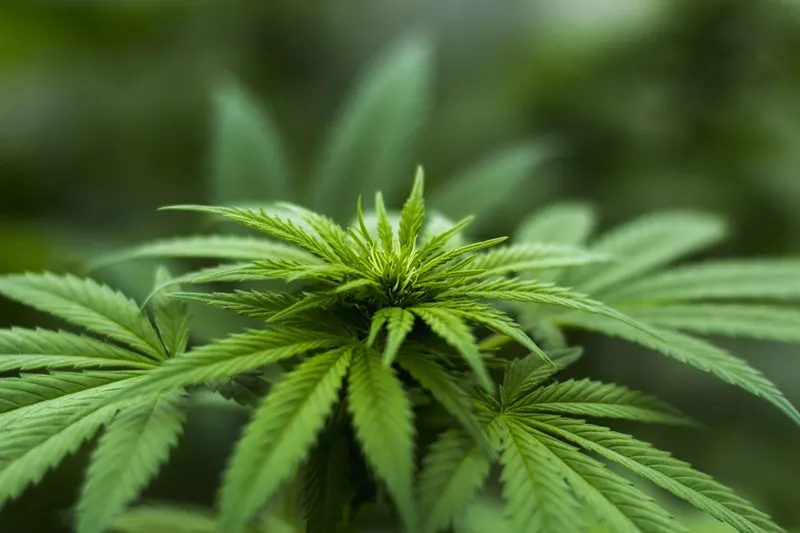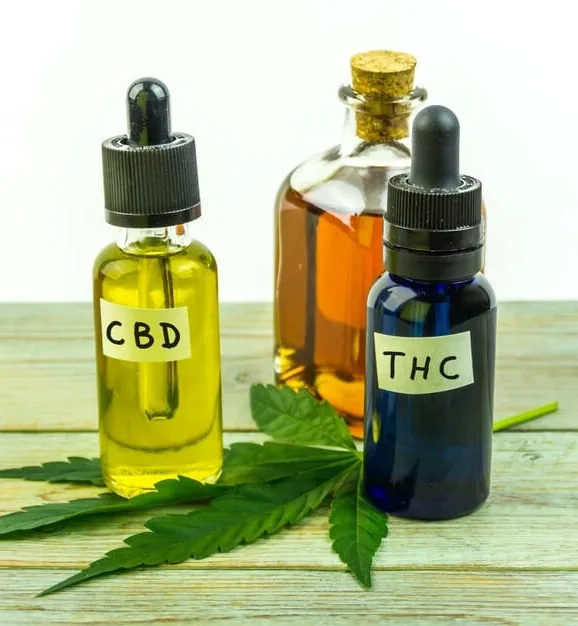I had never seen a marijuana plant (cannabis sativa) until a few years ago when I visited a friend of mine out in my home state of Oregon. She and her husband had a beautiful specimen which I studied momentarily, musing about the fact that a plant can be “illegal” in many areas. The concept had never seemed so ludicrous until that very moment. I no longer believe in illegal plants, but perhaps unwise use of some (or many) plants…

Many years ago, I heard the story of a woman living in Portland, Oregon… She had ended up with an interesting (and beautiful) plant which she placed on her living room window to benefit from the sunlight on her windowsill… until a police officer knocked on her door and informed her that what she was growing was marijuana!
Another time, I had an aviary with various caged birds in my back garden in England. I fed them a seed mixture that included hemp seed (cannabis indica). Invariably, some began growing outside the aviary… one of my visiting friends commented on it with great interest!
Another friend that I knew on Facebook was suffering from cancer – causing her a lot of pain. She found relief from the pain with cannabis. Eventually, someone reported her to the police, who turned up and very politely expressed their regret as they destroyed her plants, and therefore, her pain relief.
Such things seem ridiculous to me, an herbalist at heart. But this has long been the situation in the USA, UK and other countries who consider themselves more civilized than others.
Until 2018, hemp was considered a controlled substance in the USA, along with its more psychoactive brother, marijuana. As more states have adopted medical marijuana and even legal recreational use, the use of medicinal hemp has skyrocketed. But why? Is it really a magic bullet for sleep and mental disturbances?
Although hampered by legality issues, scientific studies are beginning to uncover what many have pushed for years – that cannabinoids have high potential for medical use with many healing properties.
Cannabis Sativa vs Cannabis Indica
There are two different cannabis species that are in popular production.
Cannabis Sativa is high in THC (tetrahydrocannabinol) – which is psychoactive (and illegal in many areas.) This plant is considered useful for its uplifting effects giving the user uncontrollable laughter, engaging conversations and creative thinking. (Sounds scary, doesn’t it?)
Cannabis Indica is high in CBD (cannabidiol) and low in THC – which is generally legal in most parts of the USA at this time. This plant is indicated for reducing stress, relieving pain and helping anxiety or insomnia.
There are also hybrids between the two with a meshing of effects of both plants, but generally creating relaxation, mind/body balance and relieving anxiety.
Different strains have varying benefits (and probably varying legality) as well as unique names such as Amnesia Haze, Northern Lights and Blue Dream. There are even websites dedicated to helping you figure out which strain might help you the most depending on what you most need.
The low-down on cannabinoids
CBD and THC are only the two most studied of over 100 compounds referred to as cannabinoids contained in cannabis plants. The breakdown depends on which species or hybrid involved… or even the part of the plant… Marijuana only refers to the THC-rich portions of C. Sativa, whereas the rest of the plant is hemp – as well as the species C. Indica.
Tetrahydrocannabinol (THC) – the more psychoactive of the pair is primarily in C. Sativa. Hemp (C. Indica) contains less than 0.03% THC which is why it was able to retire its controlled substance status in 2018.
Cannabidiol (CBD) – Does not have psychoactive properties and is non-addictive meaning that it can be legally sold and marketed accordingly. Although still early days when it comes to research, CBD has become increasingly popular for many purposes.
Why cannabis might be useful
With legality relaxing on both C. Indica and C. Sativa, research and development into medical uses of cannabis has exploded with plenty of findings that the plants are useful in treating a number of illnesses and conditions… some even approved by the FDA, others still speculative at this time.
FDA-approved drugs include:
Epidiolex has been approved for seizures caused by epilepsy, Dravet syndrome, Lennox-Gastaut syndrome and tuberous sclerosis complex in patients as young as 2. The drug might be useful for other kinds of seizures as well.
Marinol and Syndros are synthetic forms of THC and dronabinol, a chemical that might help control appetite, nausea and vomiting in patients undergoing chemotherapy or suffering from HIV-related weight loss.
Cesamet is a synthetic compound similar to THC, called nabilone. It also treats vomiting and nausea in chemo patients.
Elixicure is a CBD-infused, over-the-counter topical pain cream product.
Beyond this, treatments for anything must be considered experimental and speculative. Here are some of the other possible uses for cannabis.
Sleep disorders including REM sleep behavior disorder (“verbalization and aggressive movements”), insomnia, obstructive sleep apnea (OSA), Restless Leg Syndrome, excessive daytime sleepiness disorder. It helps regulate the body’s circadian rhythm.
Nervous disorders such as Alzheimer’s, ADHD, Parkinson’s, Tourette’s Syndrome, multiple sclerosis. It can reduce spasms and improve walking.
Mental disorders such as mood disorders, anxiety, anorexia nervosa, PTSD, schizophrenia, substance abuse and cognitive decline. Apigenin, one of the flavonoids in cannabis seems to be anti-anxiety in nature.
Inflammatory and Hystamine disorders including acne, eczema, psoriasis, rosacea, headaches and tumors. Apigenin (again) appears to be anti-inflammatory.
Physical relief such as arthritis, pain, and a possible substitute for aspirin thanks to cannaflavin A which is anti-inflammatory.
Physical fitness such as weight loss, appetite suppression and “fat browning” (turning “white” fat into brown fat.) Immune functioning might be enhanced or repaired. Cannabis contains quercetin which is an antioxidant and antiviral.
Disease prevention such as: slowing the buildup of amyloid plaque, reduction of hypertension – especially in stressful situations. It might boost the immune system (especially in the compromised). It may even prevent cancer cells from proliferating. (Not FDA approved!)
Recovery from addiction including curbing nicotine and heroin withdrawal symptoms as well as reducing the psychoactive affects of THC.
Pets! - I have seen a number of links about the use of CBD oil for dogs. I haven’t researched that direction this time, but maybe for a future article.

How cannabis works
To me, one of the most interesting things about cannabis is the fact that the brain has special receptors for it – endocannabinoid receptors (CB1 and CB2) – the brain is geared for it!
When we engage the endocannabinoid system with CBD oil, a number of things change, improving our overall health.
- Alters the way the brain perceives pain.
- Reduces inflammation.
- Calms the nervous system due to its interaction with the serotonin receptors.
- Maintains body functions such as mood, appetite, sleep and circadian rhythm.
- The influence on serotonin may lead to a reduction of apneic episodes during the night in obstructive sleep apnea patients.
CBD oil may even block the proliferation of cancerous cells (as well as help relieve the pain associated with the disease.) Please remember that this is not approved by the FDA! Don’t change your regimen based on this article – and certainly not without talking to your doctor.
Also note that outcomes vary from person to person and also depend on the product and dosage. What might be stimulating for one might be sedating for the next… Be cautious, and talk to your doctor about any concerns or questions you might have.
Early Studies
One study from 2016-2018 on insomniacs tested the cannabis flower. They used various forms including vaping and smoking. The average participant had significant decreases in their symptoms. However, as the flower has multiple cannabinoids, it cannot be ascertained from that study whether it was CBD, THC or some other chemical that had the greatest impact.
Another study used 25 mg of CBD oil in the evening (for insomnia) or morning (for anxiety.) The participants showed impressive improvements. Though the results were stronger for anxiety, the oil still seemed to help sleep.
Clearly, more research needs to be done, but the fact that there are now a number of FDA-approved uses for cannabis is encouraging. It is highly likely that more will be determined in the near future – and maybe we’ll find that some of the other cannabinoids will also be useful in medicine.
But Isn’t Cannabis Risky?
I was told in school that cannabis is a “gateway drug” - gateway to bigger, more terrible drugs! Yet, the more I learn as an adult, the less I believe this idea.
Some of the FDA-approved, cannabis-based medications do have some minor side effects. Epidiolex patients are warned of potential diarrhea or other gastrointestinal issues. Some may experience drowsiness or fatigue. Other side-effects might include dry mouth and reduced appetite.
The most serious side-effect is that it might interact with other medications. This is largely due to the fact that CBD can slow drug metabolism in the liver as well as reduce the activity of drug transporters. This would both slow and prolong the effects of medications you are already taking.
- blood thinners, antidepressants and statins are ones to watch.
- any drug with a “grapefruit warning” - consult your doctor and use with caution.
If you are on other medications, talk to your doctor before beginning CBD.
For sleep, CBD seems to be taken best in higher doses for a short term – the first month shows the best results. Long term, the effects diminish with the possibility of dependency (like with any sleep medication) and a long term decrease in sleep quality (even more so if you’re using THC.) So, maybe just take it for a month while you’re working on your other sleep issues – or switch it to mornings if you have anxiety – just an idea. I’m not a doctor!
Beyond that, side effects in cannabis seem to be mild, if any. (Though my cousin is allergic to it.) Many side effects, however, might be dose-dependent as low doses seem to be stimulating while high doses may be more sedating.
It seems that the cautions are similar to any medication…
- Don’t take it before driving.
- Caution with pregnancy.
- Extreme caution with other medications.
- Talk to your doctor, if you have any doubts or concerns.
Note that CBD doesn’t seem to produce withdrawal symptoms.
How to choose a CBD product
It is important to know your source as poor quality products may not be accurate in the amount of CBD (or THC) in the product. Some have a lot less and some have a lot more… You don’t want to fail a drug test (or worse) because of poor labeling!
- Location – Note where and how it was grown – especially as hemp is useful in cleaning up polluted soils.
- Formulation – Is it combined with other sleep supplements? (Some can make them more effective.)
- Extraction – Whether CO2, olive oil or ethanol (for vaping), it’s important to know what you’re taking.
- Third-party testing – That’s the best way to avoid the problem of poor labeling and wasting your money.
- Company vision/reputation – Spend a few minutes on the company website. Some have educational sections to help you understand cannabis far better than my short article can. Also check external review sites and remember that one negative review is generally worth about ten positive ones as people are far more likely to complain than praise!
Decide whether you want a full-spectrum CBD or an isolate.
The full-spectrum will be cheaper and more beneficial, overall, but more likely to show on a drug test.
The isolate will be more expensive, less beneficial, but less likely to show on a drug test.
Finally, you’ll want to choose what kind of product you wish to try first (or next):
How to take CBD (or other cannabinoids):
Firstly, there’s dose. The exact dose to recommend isn’t fully known yet. However, 300 mg oral doses can be taken daily for up to six months without problems. Even 1500 mg daily up to four weeks. Exercise caution and start small – you can always increase later if that’s what you find to be beneficial.
There are lots of options as to how to take CBD.
- oral supplements – in the form of pills or capsules
- edibles – include gummy bears, cakes, cookies – usually listing the CBD dose on the package
- topicals – in the form of lotions, creams, patches, gels and ointments
- vaping – through a vaporizer or vape pen (the latter might cause other health issues)
- tinctures – a concentrated liquid to add to drinks or place sublingually (beneath the tongue)
Conclusion
There are so many truly dangerous plants in the world. It seems strange, to me, that cannabis has been so ill-treated by our governments, when it has so many uses for our improved health. I hope that this article has shed some light on this beautiful plant and maybe it can benefit your health too.
This article was written without regard to any specific company whose affiliate links are on this page. (I may do a brief post on each company in time – and review their products if given the chance.)
Resources:
CBD Awareness Project
CFAH
Medical News TodaySleep Advisor
Sleep Association – including study information
Sleep Foundation
Get 20% off when you use the discount code: FREYASMOOD - thru Jan 2024!

Images from:
Piqsels
Goodmoodfarms at Wikipedia
Crossposted on my Wordpress Blog. Contains affiliate marketing links.
Join shareasale.com, Earn Cash! (Affiliate link)
Freya Domestica is my new brand - on Wordpress and RedBubble - addressing the needs of the modern (aspiring) domestic goddess. Please come for a visit. Also visit Freya's Moods on YouTube for help with relaxation and sleep! Help me have time for writing again!
Previous Posts from Freya Domestica
Sleep Deprivation: A Common Problem - Best Methods for Better Snoozing
Lori Svensen
author/designer at A'mara Books
photographer/graphic artist for Viking Visual
(Buy my work at RedBubble, TeePublic, PicFair and DeviantArt.)
verified author on Goodreads
(Buy my books at Books2Read and at LBRY)
find me on Twitter




